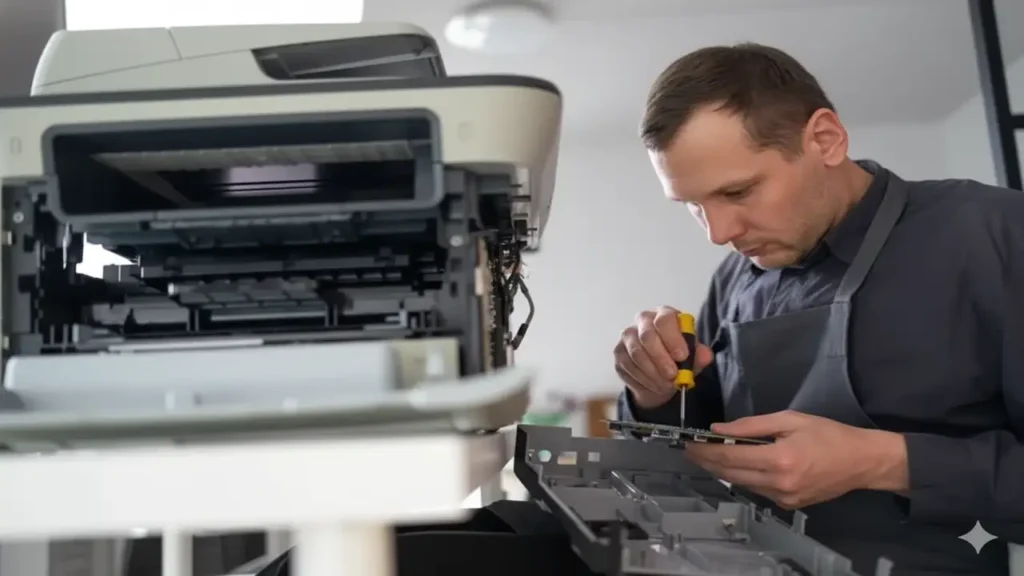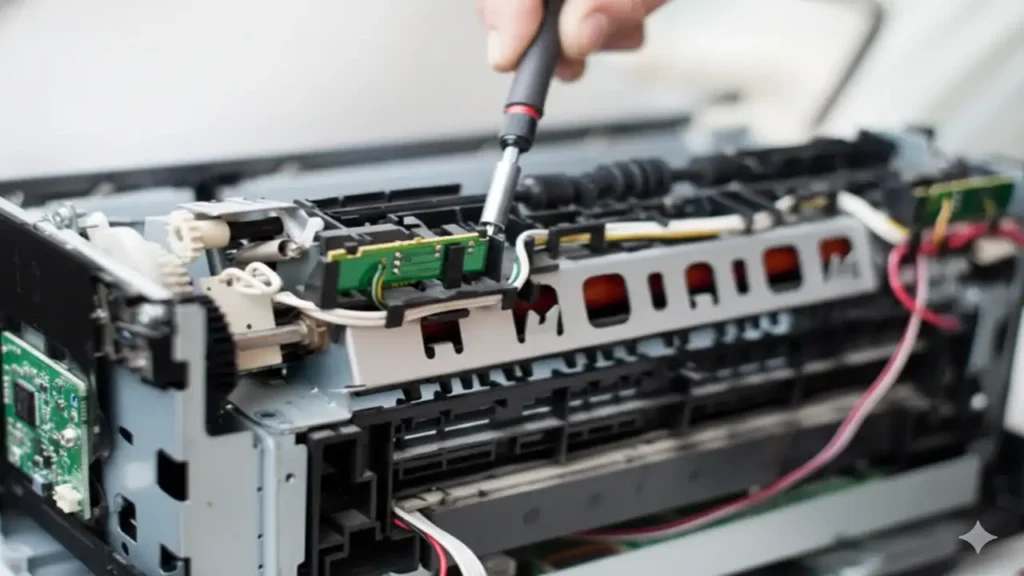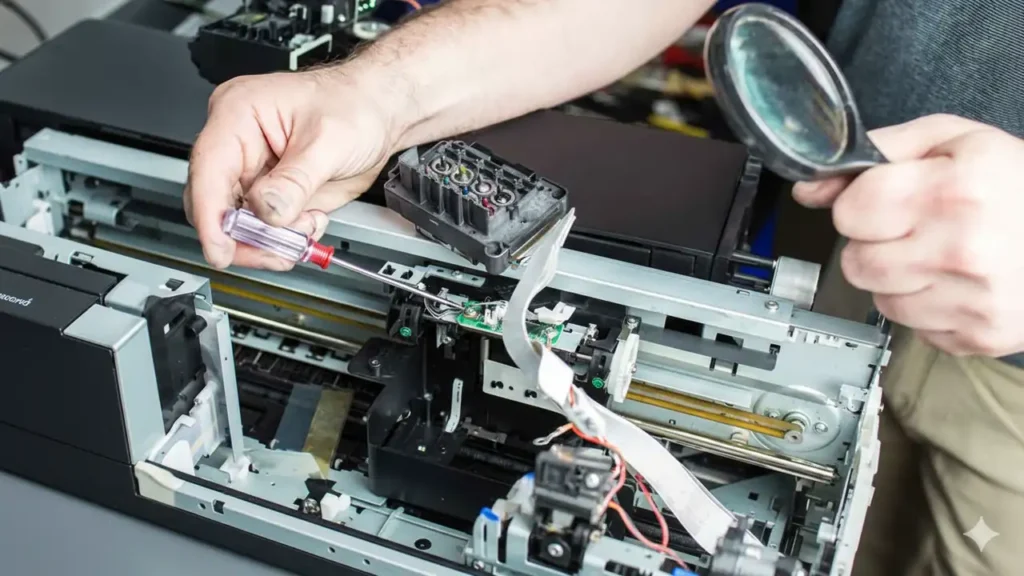
Dealing with common printer repair issues is a frequent frustration in homes and offices. When printers fail, understanding the cause and knowing whether to attempt a fix, call for service, or simply replace the unit can save significant time and money. This guide tackles the 5 most common printer repair issues, explains their causes, provides solutions, and offers a clear framework for the crucial “repair vs. replace” decision, keeping common printer repair issues in mind.
Part 1: Top 5 Common Printer Repair Issues & Solutions
1. Paper Jams: A Frequent Printer Repair Issue
Paper jams are arguably the most annoying and common printer repair issue. While seemingly simple, persistent jams often signal underlying problems.
- Causes:
- Paper Problems: Using the wrong type, size, or low-quality paper. Damp or damaged paper is also a major cause.
- Loading Errors: Overfilling the tray or misaligning paper guides.
- Worn Components: Dirty or worn-out rollers (“feed tires”) lose grip. Cleaning might help temporarily, but replacement is often needed.
- Obstructions: Foreign objects like staples, paper clips, or torn paper fragments blocking the path , especially common in Automatic Document Feeders (ADFs).
- Fix: Carefully check the entire paper path. Gently remove stuck paper in the direction of paper travel to avoid damaging parts like the fuser claw. Clean accessible rollers. If jams persist, it’s likely a hardware-related printer repair issue requiring a technician.
2. Poor Print Quality: Diagnosing This Printer Repair Issue
Streaks, spots, smudges, or faded prints are symptoms pointing to specific component failures, a key area for diagnosing common printer repair issues.
- Laser Printers/Copiers:
- Lines on ADF Copies: Usually dirt (ink, Wite-Out) on the slit glass (narrow strip left of main glass). Cleaning this strip resolves the issue.
- Lines/Spots on All Prints: Often a damaged drum unit (photoconductor). Drums are typically user-replaceable consumables.
- Smearing/Toner Rubs Off: Indicates a failing fuser unit (not heating correctly). This requires a technician. Using incorrect paper (e.g., inkjet paper) can cause this.
- Inkjet Printers:
- Streaks/Missing Colors: Almost always a clogged printhead due to dried ink, especially with infrequent use.
- Fix: Run the printer’s automated “Clean Printhead” function multiple times. If ineffective, gently clean contacts on cartridges and carriage. For persistent clogs on low-cost inkjets, replacement is usually cheaper than repair.
3. Error Codes: Interpreting This Printer Repair Issue
Error codes can signify anything from a minor glitch to a major hardware failure, making them critical to understand when facing common printer repair issues.
- First Step: Full Reboot (Power Cycle): Turn off using the Power/Wake button, then turn off the main power switch (if applicable), unplug from the wall for 60 seconds, plug back in, power on the main switch, then use Power/Wake button. This clears temporary errors. If the code returns, it’s likely a hardware fault.
- User-Fixable Codes: Paper Jam (e.g., Xerox 077-900), Low Ink/Toner, Printer Offline, Incompatible Cartridge (reseat/replace), Canon 5100 (carriage obstruction).
- Technician Required: Fuser errors (Sharp H4-00), motor failures (Sharp L4-06), fatal printhead errors (Canon B200), other internal hardware faults (HP 56, 58, 59) generally need professional service.
4. Network/Connectivity Problems: An Often Misdiagnosed Printer Repair Issue
If your printer is “Offline” or scanning fails, it’s typically a network configuration problem, not a hardware printer repair issue.
- Causes:
- New Router/Wi-Fi Change: Printer needs updated network credentials (SSID/password).
- IP Address Change: Dynamic IP addresses can shift, breaking scan-to-folder/email links or print connections.
- Fix:
- Reconnect Wi-Fi: Use the printer’s control panel (Network/Wireless settings) to run the setup wizard and connect to the new network.
- Set Static IP Address: Assign a permanent IP address via the printer’s web interface (accessed through its current IP in a browser) to prevent future changes.
Frequently Asked Questions
5. Unusual Noises: Acoustic Clues to Printer Repair Issues
Squeaking or grinding sounds are warnings of mechanical problems.
- Squeaking: Usually dry or worn rollers needing lubrication or replacement. A call for maintenance, but not critical failure.
- Grinding: A severe warning, often indicating broken gears or a major obstruction. Stop using the printer immediately to prevent further damage and call a technician.

Part 2: Repair vs. Replace – Solving Common Printer Repair Issues Economically
When faced with common printer repair issues, deciding whether to repair or replace is crucial.
DIY vs. Professional Repair for Printer Repair Issues
- DIY: Best for simple issues (basic jams, cleaning glass/rollers, network reconnects). Saves money but risks causing more damage if done incorrectly. Safety risks include burns from fusers.
- Professional: Necessary for internal hardware problems (fusers, gears, persistent errors, grinding noises). Technicians offer expertise and speed but cost money. Look for certified techs with good reviews and transparent pricing.
The Inkjet vs. Laser Cost Factor in Printer Repair
- Inkjets: Cheap to buy, expensive ink. Repairs ($50-$150) often exceed the cost of a new printer, making them generally disposable.
- Lasers/Copiers: Higher initial cost, lower cost per page, built tougher. Repairs ($75-$600) are usually economical compared to replacement.
Deciding When to Replace Instead of Repairing Common Printer Repair Issues
- The 50% Rule: If repair cost > 50% of a comparable new printer’s price, replace.
- The 7-Year Legacy Rule: Replace printers older than 7 years (from release date). Reasons: parts become scarce , software/driver support ends , and critical security vulnerabilities emerge.
- Frequent Breakdowns: If repairs are needed more than 2-3 times per year, replacement is often wiser.
Right to Repair & Common Printer Repair Issues
A major frustration is manufacturers hindering independent repair by restricting parts, manuals, and using software locks (“parts pairing”). “Right to Repair” laws (e.g., California, Oregon) are combating this, aiming to make parts and information accessible, potentially lowering costs for common printer repair issues.


